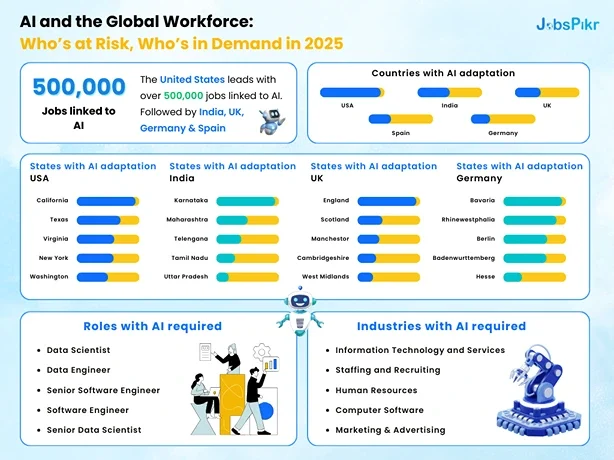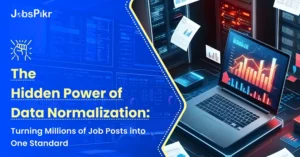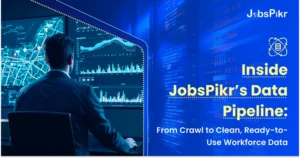Artificial Intelligence is no longer a distant disruptor—it’s now an active force reshaping how companies hire, what skills they prioritize, and how workers prepare for the future. Across industries and geographies, we are witnessing a fundamental redefinition of job roles, with some professions becoming obsolete and others emerging almost overnight.
In 2025, this shift has reached an inflection point. As AI tools become deeply integrated into business operations, enterprises are facing two urgent questions: Which industries and roles are at risk of displacement? And where are the new opportunities emerging?
This report analyzes the global impact of AI-driven job transformation through a data-first lens—tracking hiring trends, role evolution, skill emergence, and regional AI adaptation. By unpacking these changes, we aim to help workforce planners, HR strategists, and policy leaders prepare for the future of work—and act before the disruption becomes a crisis.
AI-Driven Job Displacement: Where It’s Happening Most
AI is rapidly transforming the nature of work across multiple industries. As automation technologies become smarter and more accessible, traditional roles that once relied on repetitive or rule-based tasks are seeing reduced demand. The visual titled “Countries with AI adaptation” clearly shows that:
- The United States leads with over 500,000 jobs linked to AI, signaling a widespread shift in how enterprises integrate automation.
- India follows as a distant second, yet with a strong AI foothold in states like Karnataka and Maharashtra, indicating high exposure to job transformation.
- Countries like the UK, Germany, and Spain also report growing AI adoption but at a smaller scale, hinting at more sector-specific displacement than widespread national change.

See Graph: Countries with AI adaptation (2025)
Regional Workforce Variations: A Global AI Race
United States:
- California leads with over 75,000 jobs, showing heavy AI adoption in Silicon Valley and tech hubs.
- Texas and Virginia also emerge as major adopters, showing regional tech expansion beyond the West Coast.
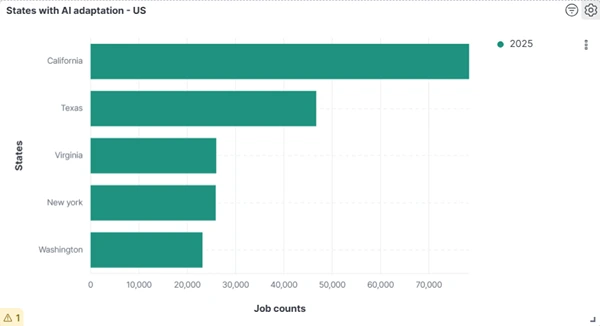
See Graph: States with AI adaptation – US
India:
- Karnataka (Bangalore) has the highest AI job counts, showing its dominance as the tech hub of the country.
- Telangana and Maharashtra follow closely, signaling decentralization of AI-focused talent.

See Graph: States with AI adaptation – India
United Kingdom:
- England accounts for a lion’s share of AI-related jobs, followed distantly by Scotland and Manchester, reflecting London-centric AI development.
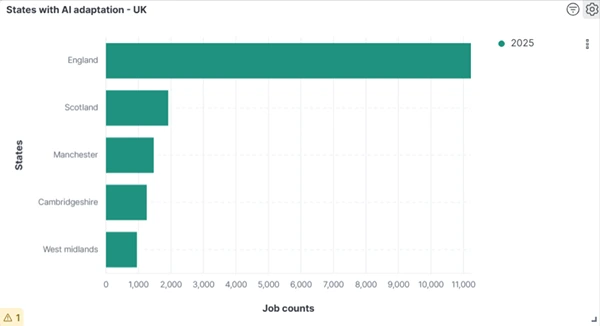
See Graph: States with AI adaptation – UK
Germany:
- Distributed AI job growth with Bavaria, Berlin, and North Rhine-Westphalia showing similar levels of AI-related hiring.
- Suggests strong AI research ecosystem spread across key innovation regions.
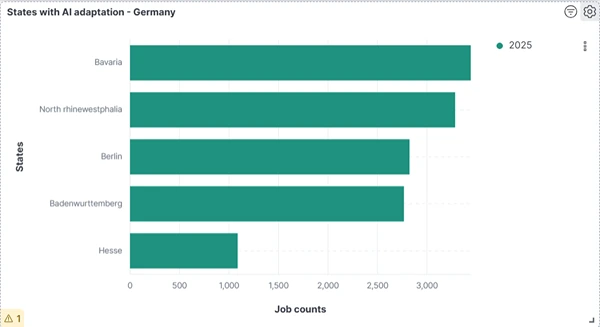
See Graph: States with AI adaptation – Germany
Skill-Based AI Infiltration: Historical View of Job Replacement
By analyzing job descriptions over the past few years, there’s a notable pattern:
- Job listings that once focused on “IT Support,” “Clerical Processing,” or “Manual QA” roles have now added AI-specific skills such as “machine learning,” “NLP,” “predictive analytics,” and “automation scripting.”
- Skills like Python, TensorFlow, and AI model deployment appear more frequently, while legacy tools and process-driven roles fade.
Based on your historical insights (e.g. Historical-insights-for-Marketing-Elastic images), this shift has accelerated since 2022, with 2024-2025 showing the most significant skill set change year-on-year.
Emerging Roles in AI-Intensive Sectors
Looking at the visual titled “Roles with AI required”, the emergence of specialized AI roles becomes evident:
- Data Scientist and Data Engineer top the list, with over 3,000 job counts.
- Interestingly, even traditionally broader roles like Senior Software Engineer and Software Engineer now list AI/ML competencies.
- New-age job roles such as AI Prompt Engineer, AI Product Manager, and even titles like “Code Ninja” are starting to appear in 2025 job postings.
These roles demand hybrid skills—technical fluency in AI frameworks, domain-specific knowledge, and the ability to work with large datasets.
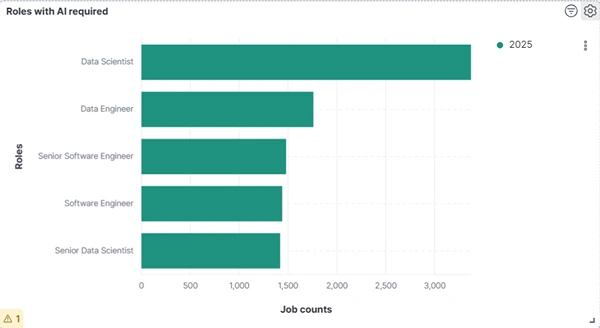
See Graph: Roles with AI required (2025)
High-Growth Sectors Fueling AI Job Demand
The “Industries with AI required” chart highlights the industries pushing AI-driven hiring:
- Information Technology and Services dominates with over 250,000 jobs.
- Staffing & Recruiting and Human Resources—traditionally human-centric domains—now depend heavily on AI for candidate matching, sentiment analysis, and workforce planning.
- Marketing and Advertising shows substantial growth, driven by AI’s role in content generation, personalization, and targeting.
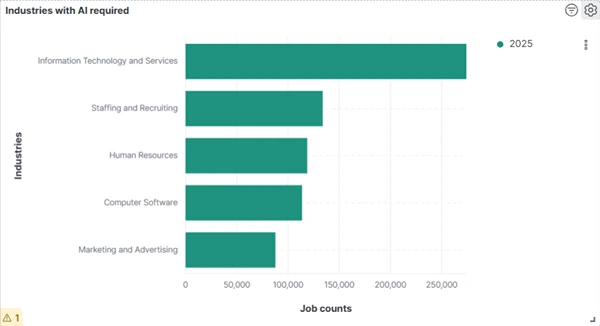
See Graph: Industries with AI required (2025)
AI Isn’t the Future—It’s the Present
AI adoption is no longer a matter of if—it’s already reshaping how organizations hire, train, and structure work. With the rapid acceleration of AI-related job listings across roles, industries, and geographies, enterprises must:
- Assess displacement risk across existing job functions.
- Invest in AI upskilling programs and cross-role transition paths.
- Stay ahead by continuously tracking job market trends and skill demands.
Sign up on JobsPikr to access real-time labor market data, AI job trends, and region-wise adaptation insights to support your workforce strategy.
